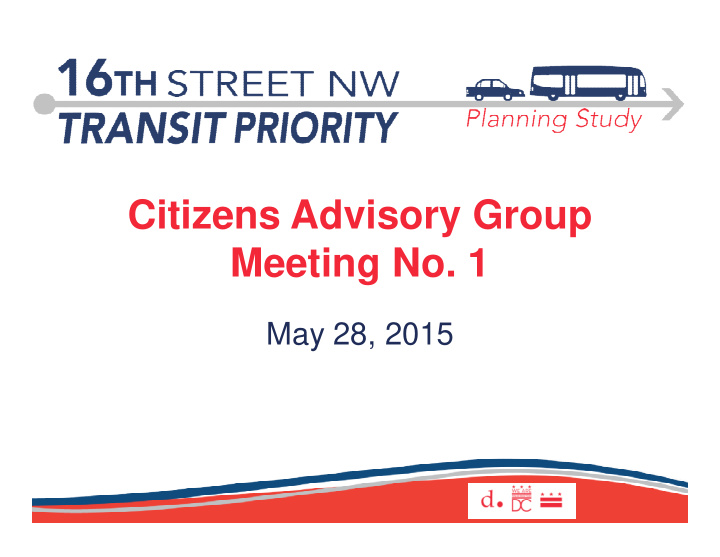



Citizens Advisory Group Meeting No. 1 May 28, 2015
Agenda 1. Welcome 2. Overview 3. Public Kick-off Meeting 4. Transit Data Analysis 5. Physical Conditions Assessment 6. Next Steps
OVERVIEW
Arkansas Avenue NW Study Area Primary Study Area • 16 th Street NW from H Street to Arkansas Avenue treet NW Secondary Study Area 16 th S • Bounded by 14 th Street, 18 th Street, Taylor Street and H Street H S treet NW
Lane Configurations Reversible lane
Goals • Improve travel for persons using public transit • Develop alternatives based on public and stakeholder input • Evaluate alternatives in terms of their benefits to transit users, possible impacts on other users of the corridor, and safety
Objectives 1. Improve transit service reliability and travel times by identifying and addressing sources of problems 2. Prioritize transit while maintaining operations for those traveling by other modes 3. Improve rider comfort and safety 4. Accommodate current unmet passenger demand for public transit service 5. Develop an implementation plan that includes costs estimates
Metrics 1. Improve transit service reliability and travel times • Reduction in end-to-end travel/segment-by-segment travel time • Improvement in on-time performance • Reduction in dwell time • Reduction in dwell time as a percentage of run time 2. Optimize operations • Multimodal level of service, travel time, queuing, person throughput 3. Improve rider comfort and safety • Load factor • Number of bus stops at uncontrolled intersections • Pedestrian crossing improvements
Metrics 4. Accommodate unmet passenger demand • Service capacity 5. Develop a feasible solution • Cost • Implementation time • Consistency with bus operating parameters (e.g., bus widths, turning radii, dynamic envelope, and others) • Management and enforcement requirements
Outcomes We Are Seeking • Preferred set of improvements • Concept design • Build on measures implemented to date
PUBLIC KICKOFF MEETING
What Are Problems? Most Noted Issues: • Bus Bunching (31 flags) • Overcrowding on the Bus (29 flags) • Bus Passes by the Stop (23 flags) • Traffic Congestion (17 flags)
Where Are Problems? Most Noted Intersections: • U Street NW (22 flags) • Euclid Street NW (19 flags) • Park Road NW (15 flags) • Irving Street NW (10 flags)
Where Are Problems Issues Encountered Along 16th Street NW Over- Pedestrian Bus Lack of Over- crowding Safety Conflicts Bus Cross Parking Traffic crowding at Bus Accessing with Bus Passes Streets Enforcement Congestion on Bus Stop Stop Bicycles Bunching Stop Total U St 4 6 3 2 2 5 22 Euclid St 1 5 2 1 5 5 19 Irving St 1 2 1 2 3 1 10 Park Rd 3 1 6 1 3 1 15 Total in 7 17 29 12 5 8 31 23 132 Corridor
What Is Important? • Bus Arriving on Time (46 dots) • Travel Time on the Bus (37 dots) • Enough Room on the Bus to Sit or Stand Comfortably (33 dots) • Room to Board the First Arriving Bus (22 dots)
Key Takeaways Strong Support Limited Concern • Additional Service • On-street Parking • Enforcement • Signal Optimization and Priority • Dedicated Bus Lanes
TRANSIT ANALYSIS
Time-Distance: AM Peak SB Bus bunching prior to study area Gap in bus service Bus passing Slow down in bus speed
Time-Distance: PM Peak NB Slow down in bus speed Bus bunching and pass by Slow travel time I St – M St Overlapping S9 service due to high boardings
Travel Speed* – Southbound Early AM Peak AM Peak AM S1/ S2/ S4 S1/ S2/ S4 S9 Legend * Includes dwell time
Travel Speed* – PM Peak NB S1/ S2/ S4 S9 Legend * Includes dwell time
Average Travel Speed - SB S 1/ S 2/ S 4 S 9 M iles Per Hour 12 10 10.7 9.9 9.9 9.3 9.0 8.7 8.7 8 8.2 7.7 6 4 2 0 EARLY AM AM PEAK M IDDAY PM PEAK EARLY PM
Average Travel Speed - NB S 1/ S 2/ S 4 S 9 M iles Per Hour 14 12 12.3 10 10.9 10.2 9.5 8 8.9 8.5 8.4 8.1 7.3 6 4 2 0 EARLY AM AM PEAK M IDDAY PM PEAK EARLY PM
Boardings/Alightings – SB AM Peak S1, S2, S4 S9 Boardings Alightings
Boardings/Alightings – NB PM Peak S9 S1, S2, S4 Boardings Alightings
On-Board Data Collection Average S1, S2, S4 Southbound AM Peak Average S9 Southbound AM Peak Bus S top Dwell Time 16% 25% 41% S ignal or S top Time 46% Other Delays 40% 27% Running Time 3% 2% Average Average Bus Stop Dwell Time 0:03:22 Bus Stop Dwell Time 0:05:21 Signal or Stop Time 0:08:16 0:05:56 Signal or Stop Time Other Delays 0:00:43 Other Delays 0:00:21 Running Time 0:08:32 0:10:07 Running Time Total Trip Time 0:20:52 Total Trip Time 0:22:22
On-Board Data Collection
PHYSICAL CONDITIONS
Physical Conditions • Roadway and sidewalks in good condition overall • Parking restrictions signage not uniform and conflicting, damaged and obstructed signs
Physical Conditions • Bus stop signs not at optimal or compliant location • Bus Stop No Parking Zones not in compliance with zone clearance distances and/or correct signage
Physical Conditions • For stops where intended ADA landing area is at the shelter, bus shelters did not meet mandatory ADA ‘8 foot available sidewalk width’ for boarding/ unloading • Trash bins, vendor boxes, and tree locations create accessibility obstructions
NEXT STEPS
Timeline 1. CAG Meeting No. 2 – July 2015 2. Alternatives Development – Summer 2015 3. CAG Meeting No. 3 Early Fall 2015 4. Pop-ups – Early Fall 2015 5. Public Meeting – Late Fall 2015 6. Study Completion – January 2016
Stay Connected Megan Kanagy, Project Manager megan.kanagy@dc.gov Project Website bit.ly/16thStreetBus
Recommend
More recommend